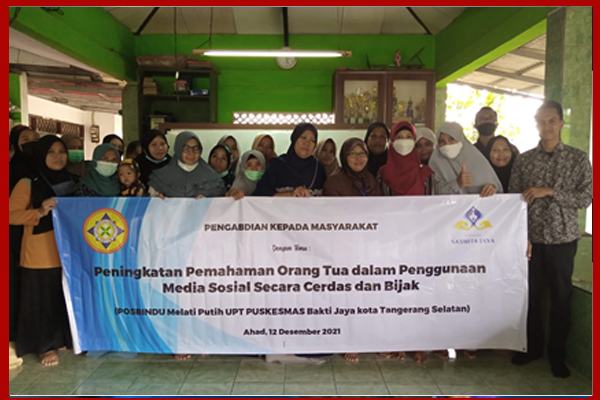IMPROVED UNDERSTANDING OF PARENTS IN THE USE OF SOCIAL MEDIA INTELLIGENTLY AND WISELY IN POSBINDU MELATI PUTIH
PENINGKATAN PEMAHAMAN ORANG TUA DALAM PENGGUNAAN MEDIA SOSIAL SECARA CERDAS DAN BIJAK DI POSBINDU MELATI PUTIH
DOI:
https://doi.org/10.53067/ijecsed.v2i1.52Keywords:
Social Media, Smart, Wise, Media Sosial, Cerdas, BijaksanaAbstract
The purpose of this Community Service activity is to educate and provide knowledge to parents on how their children can use social media intelligently and wisely. The method used in this community service activity involves, firstly, lectures using power point slides to explain to the participants. General knowledge about how to assist in utilizing social media, as well as sharing experiences through discussions and question and answer sessions. This community service resulted in increased knowledge and understanding of participants, namely housewives or parents regarding the wise and intelligent use of social media in everyday life. Based on the results of the pretest and posttest, the socialization carried out can increase understanding of Increasing Parents' Understanding of Using Social Media Smartly and Wisely at Posbindu Melati Putih
Downloads
References
Anwar, Fahmi (2017) Perubahan dan Permasalahan Media Sosial, Jurusan Ilmu Komunikasi, Kalbis Institute Jakarta, hlm 1-8.
Ayun PQ. (2015). Fenomena remaja menggunakan media sosial dalam membentuk identitas. Channel, 3(2), 1-16.
Cahyono, A. S. (2016). Pengaruh media sosial terhadap perubahan sosial masyarakat di Indonesia. Jurnal Publiciana, 9(1), 140-157.
Data Reportal. (2021, Oktober 23). Digital 2021 Indonesia. Retrieved from Data Reportal: https://datareportal.com/reports/digital-2021-indonesia.
Duggan M. Brenner J. (2013). Report, The Demographics of Social Media Users 2012. Pew Internet & American Life Project, Washington DC.
Intan, N. S., Murni, S., & Hutabarat, D. (2020). Pendampingan Penggunaan Media Sosial yang Cerdas dan Bijak Berdasarkan Undang-undang Informasi dan Transksi Elektronik. Deseminasi: Jurnal Pengabdian Masyarakat, 34-46.
Kemenkes RI. Petunjuk Teknis Posbindu PTM. Jakarta: Kemenkes RI; 2012.
Khan GF, Swar B, Lee KS. (2013). Social Media Risks and Benefits: A Public Sector Perspective. Korea TECH, Korea
Pantic I, Damjanovic A, Todorovic J, Topalovic D, Bojovic- Jovic D, Ristic S et al. (2012). Association between online social networking and depression in high school students: behavioral physiology viewpoint. Psychiatr Danubia, 24, 90-3Ibrahim, Subandy I. (2011). Kritik Budaya Komunikasi. Jalasutra, Yogyakarta
Purbohastuti, A. W. (2017). Efektivitas Media Sosial Sebagai Media Promosi. Tirtayasa Ekonomika, 12(2), 212-231.
Raharja, I. F. (2019). Bijak Menggunakan Media Sosial Di Kalangan Pelajar Menurut Undang-undang Nomor 19 Tahun 2016 Tentang Informasi dan Transaksi Elektronik. Jurnal Selat, 6(2), 235-246.
Setyawati, W. N., Supriyanto, & Dharmanto, A. (2020). Penyuluhan Pendampingan Orang Tua Terhadap Putra Putri dalam Penggunaan Bijak Bersosmed. Jurnal Pengabdian Masyarakat Ilmu Terpan, 213-218.
Setiawan, Wawan (2017) Era Digital dan Tantangannya. Seminar Nasional Pendidikan 2017, Universitas Pendidikan Indonesia, hlm. 1-34
William M, Pearson O. (2016). Hate Crime and Bullying in the Age of Social MediaConference Report. Cardiff University, England.
Wolniczak I, Cáceres-DelAguila JA, Palma-Ardiles G, Arroyo KJ, Solís-Visscher R, ParedesYauri S et al. (2013). Association between Facebook dependence and poor sleep quality: a study in a sample of undergraduate students in Peru. PLoS One., 8:e59087

Downloads
Published
How to Cite
Issue
Section
License
Copyright (c) 2022 Indonesian Journal of Engagement, Community Services, Empowerment and Development

This work is licensed under a Creative Commons Attribution-NonCommercial-ShareAlike 4.0 International License.












